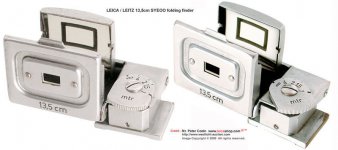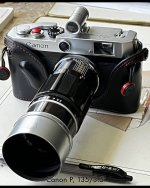davhill
Canon P
I have a Canon P (which does NOT have the automatic parallax correction nubbin for external viewfinders.)
What happens if I use an automatic-correction external viewfinder with the P? Do I get an 'infinity' view, or a close-range parallax-corrected view?
dave
What happens if I use an automatic-correction external viewfinder with the P? Do I get an 'infinity' view, or a close-range parallax-corrected view?
dave
Mackinaw
Think Different
Just tried putting an auto-parallax viewfinder on my P. If not giving a close-focus view, it's approaching it (six feet?). Definitely not an infinity.
Jim
Jim
davhill
Canon P
Ok, thank you. That rules out a whole bunch of buying options 
Manually corrected viewfinders (for the 135, in my case) come in two flavors: a long tube, with a distance dial for parallax correction; and a short fat (and presumably brighter) variety, with a base-mounted lever to adjust for parallax. Are the long tubes really really dim, or are they actually useful? What's the best solution here?
Manually corrected viewfinders (for the 135, in my case) come in two flavors: a long tube, with a distance dial for parallax correction; and a short fat (and presumably brighter) variety, with a base-mounted lever to adjust for parallax. Are the long tubes really really dim, or are they actually useful? What's the best solution here?
Coldkennels
Barnack-toting Brit.
Manually corrected viewfinders (for the 135, in my case) come in two flavors: a long tube, with a distance dial for parallax correction; and a short fat (and presumably brighter) variety, with a base-mounted lever to adjust for parallax. Are the long tubes really really dim, or are they actually useful? What's the best solution here?
If you're looking for a 135mm viewfinder, there's a third option: the SYEOO.

When I was looking for a 90mm finder, I ended up going for the 90mm equivalent of this (the SEROO) over all the other alternatives, whether Canon, Leica, or Voigtlander; dedicated, tubular, bright-line or multi-finder. Why? Because it's bright, it folds totally flat (easier to carry), the adjustment dial is nice and straightforward, and (at least with the 90mm one - I've not seen the 135mm one for some years now!) it's 1:1, meaning you can use it with both eyes open.
It's typically a little more expensive than the alternatives but I think it's worth it.
Mackinaw
Think Different
I have a Canon P (which does NOT have the automatic parallax correction nubbin for external viewfinders.)
What happens if I use an automatic-correction external viewfinder with the P? Do I get an 'infinity' view, or a close-range parallax-corrected view?
dave
An addendum to my earlier post. Viewing angle accuracy varies with focal length of the viewfinder. My parallax-corrected 25mm viewfinder gives me a pretty accurate framing image when put on my P, Leica M, or any camera that doesn't have the auto-parallex feature. On the other hand, my 50mm parallax-viewfinder is biased toward close-focus when mounted on a camera that doesn't have the parallax pin.
JIm B.
The Nikon late 13.5cm finder is nice.
https://www.ebay.com/itm/154597201178
But expensive.
Almost cheaper to pick up a Canon 135 with the older finder with the lens.
https://www.ebay.com/itm/154597201178
But expensive.
Almost cheaper to pick up a Canon 135 with the older finder with the lens.
Trask
Established
It makes sense that any of the auto-parallax correction viewfinders would give a near-focus view if used with a non-Canon-auto-parallax body. As the engagement between the auto-parallax viewfinder and the appropriate body consists of a small pin moving up and down in the accessory show, the default for the viewfinder would have to be that it is spring-loaded to aim downwards, to a near-focus distance. It's possible to spring-load a viewfinder to aim downwards and then be pushed up with a pin (if the upward pressure is placed in front of the viewfinder pivot point), but there would not be any way to spring-load the viewfinder to aim upwards and then be pulled down by the pin.
In any case, a word of caution: don't ever use a non-auto-parallax viewfinder with a Canon camera designed for auto-parallax viewfinders, for the little pin that would normally drive the correct viewfinder upwards will instead encounter the immovable bottom of the non-auto-parallax viewfinder. In so doing, the mechanism to move the pin up and down can be damaged/bent, to the extent that the pin will no longer move upwards as far as it should, meaning the auto-parallax viewfinder would thereafter never be moved upward enough to achieve the correct view for infinity. Don't ask me how I know...
In any case, a word of caution: don't ever use a non-auto-parallax viewfinder with a Canon camera designed for auto-parallax viewfinders, for the little pin that would normally drive the correct viewfinder upwards will instead encounter the immovable bottom of the non-auto-parallax viewfinder. In so doing, the mechanism to move the pin up and down can be damaged/bent, to the extent that the pin will no longer move upwards as far as it should, meaning the auto-parallax viewfinder would thereafter never be moved upward enough to achieve the correct view for infinity. Don't ask me how I know...
largedrink
Down Under
I have a Canon accessory called a Finder Coupler. It has manual parallex correction and also compensates for the offset between the accessory shoe and the lens centre line on the Canon P. I can't recall which finders it's recommended for.
davhill
Canon P
If you're looking for a 135mm viewfinder, there's a third option: the [Leitz] SYEOO. When I was looking for a 90mm finder, I ended up going for the 90mm equivalent of this (the SEROO) over all the other alternatives, whether Canon, Leica, or Voigtlander; dedicated, tubular, bright-line or multi-finder. Why? Because it's bright, it folds totally flat (easier to carry), the adjustment dial is nice and straightforward, and (at least with the 90mm one - I've not seen the 135mm one for some years now!) it's 1:1, meaning you can use it with both eyes open. It's typically a little more expensive than the alternatives but I think it's worth it.
Well yes, I agree with all that. And yet .. $200+ .. how to put this delicately? "Until I get to know the lens better, I'm damned well not spending twice its value on a finder". Fact is, I bought this 135/3.5 by mistake. It was mis-advertised as a 100/3.5, but I paid under a hundred, and its such a flawless lens despite the price, I'm keeping it. Hence the need for a finder. So today I'll probably spend $25 on a tubular finder and thank you for the advice which I'll set on a back burner, to consider later.
Come to think of it, there's also the Canon Sports Finder. Also folding, if not quite so compactly
dave
davhill
Canon P
An addendum to my earlier post. Viewing angle accuracy varies with focal length of the viewfinder. My parallax-corrected 25mm viewfinder gives me a pretty accurate framing image when put on my P, Leica M, or any camera that doesn't have the auto-parallax feature. On the other hand, my 50mm parallax-viewfinder is biased toward close-focus when mounted on a camera that doesn't have the parallax pin. Jim B. .
Good point, Jim .. viewfinder accuracy becomes more critical with longer lenses, and mis-corrected parallax on a 135 is apt to put the view completely out of the picture. I'll find one with manual correction. Dave.
davhill
Canon P
I have a Canon accessory called a Finder Coupler. It has manual parallax correction and also compensates for the offset between the accessory shoe and the lens centre line on the Canon P. I can't recall which finders it's recommended for.
Ah, yes, the Finder Coupler -- its for use with auto-parallax finders on a body without the correction feature (like the Canon P). It has a manual adjust lever which pushes a pin to activate the auto-parallax finder. Nice unit. Something else to consider .. later.
davhill
Canon P
The Nikon late 13.5cm finder is nice.
https://www.ebay.com/itm/154597201178
But expensive.
Almost cheaper to pick up a Canon 135 with the older finder with the lens.
Ooo. Yes, very nice. But see above: ""Until I get to know the lens better, I'm damned well not spending..."
davhill
Canon P
In any case, a word of caution: don't ever use a non-auto-parallax viewfinder with a Canon camera designed for auto-parallax viewfinders, for the little pin that would normally drive the correct viewfinder upwards will instead encounter the immovable bottom of the non-auto-parallax viewfinder. In so doing, the mechanism to move the pin up and down can be damaged/bent, to the extent that the pin will no longer move upwards as far as it should, meaning the auto-parallax viewfinder would thereafter never be moved upward enough to achieve the correct view for infinity. Don't ask me how I know...
Point taken. Not asking. My condolences.
Coldkennels
Barnack-toting Brit.
Well yes, I agree with all that. And yet .. $200+ ..
For what it's worth, the prices for both the SYEOO and it's narrower cousin the SEROO vary WILDLY. Here in the UK, the well-respected Red Dot Cameras in London have a "good user" SYEOO for £149/$183; Peter Loy, a much more reasonable chap, has one in better condition complete with box for £75 (about $92). At the latter price, it's almost reasonable (if you're committed to 135mm lenses in general), as it's only fractionally more expensive than the regular ol' Leitz brightline finders. At Red Dot's price...
...well, you'd have to really, really love that 135mm.
davhill
Canon P
I’m seeing $200..$600 for SYEOO’s in the US ‘bay
, though just received an offer .. only $175! <sigh>
I’ve just paid $20 for a tubular finder, stated ‘NOS’ and presumably in good shape. And another $10 for a 135 lens case with the finder pocket in the lid. I’m all in, now, baby!!
, though just received an offer .. only $175! <sigh>
I’ve just paid $20 for a tubular finder, stated ‘NOS’ and presumably in good shape. And another $10 for a 135 lens case with the finder pocket in the lid. I’m all in, now, baby!!
davhill
Canon P
Received the Canon 135 tubular finder.. and my most immediate impression is ‘tiny’ — its smaller than I anticipated. Perfect condition, reasonably bright for what it is. 1:1 view, so it’s suitable for both-eyes-open. I daresay this unit is NOT suitable for eyeglasses: even with my eye very close I can’t quite see the limits of the frame .. and will have to experiment to find out how the visible framing matches up to capture.
davhill
Canon P
Share:
-
This site uses cookies to help personalise content, tailor your experience and to keep you logged in if you register.
By continuing to use this site, you are consenting to our use of cookies.


